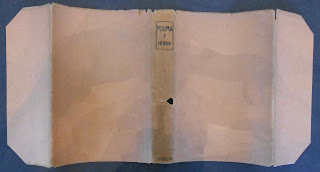 It is our week for thinking about book covers. We just blogged a mundane 19th-century book jacket--here is the polar opposite. Kenneth Patchen is famous for his hybrid poem/images. As he wrote, he would draw, and those drawings illustrated the poems (or maybe the poem was an ekphrastic manifestation of the drawing...). Anyway, his books are commonly picture/poem throughout.
It is our week for thinking about book covers. We just blogged a mundane 19th-century book jacket--here is the polar opposite. Kenneth Patchen is famous for his hybrid poem/images. As he wrote, he would draw, and those drawings illustrated the poems (or maybe the poem was an ekphrastic manifestation of the drawing...). Anyway, his books are commonly picture/poem throughout.Patchen's love of drawing spills out onto the covers. Rather than issue separate fancy editions for his books, Patchen took one hundred copies of the regular trade editions of nine titles and turned them into limited editions by painting their covers and adding a handwritten colophon. The result is a limited edition of 100 copies, each unique! Here is our copy of Hurrah of Anything, 1957.
Come in and take a look by asking for Val817 P271 R6.


